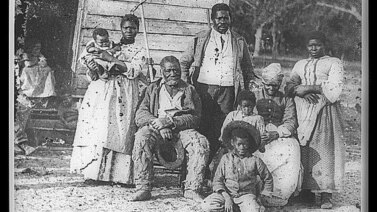
Welcome to This Is America from VOA Learning English. I’m Avi Arditti.
And I’m Kelly Jean Kelly. This week, we look at weddings in America—how much they cost and how different they can be.
(MUSIC: Bruno Mars “Marry You”)
More than 2.3 million couples get married in the United States every year. Sometimes a couple may simply go to a courthouse or city hall and be married by a judge or other official. But more elaborate wedding ceremonies are big business, adding $70 billion to the American economy every year.
Weddings also often require couples to plan ahead. Bic Decaro was married in 2003, 13 months after her future husband asked her to marry him.
“You know, we thought we wanted at least a year to just plan and not feel rushed. And we thought that was just a choice we were going to make because that is what we wanted. But it turns out when we started calling around, a lot of venues were already booked.”
The difficulty of finding a place, or venue, is not a surprise to Susan Smith, who is a professional wedding planner.
“In general most brides want to get married on a Saturday night. So that is a limited date. And again it goes back to if they want the venue then they will have to wait until it’s available or change their date. Also just the process takes much longer than what people think.”
Susan Smith says weddings often also cost more than people expect.
“It is very easy to get carried away. I mean with websites and television shows all about weddings, it’s easy to see things that you can’t afford and then you want them. And then it’s easy to start to run over budget.”
M.Z. Hemingway wrote in the Wall Street Journal newspaper in 2007 that she went to a wedding expo five months before her wedding. An expo is an event where couples can look at every type of business selling anything connected to weddings. She discovered that businesses offering the best flowers, cakes and wedding photos were already scheduled for the day she wanted.
She wrote that the average cost of a wedding in the United States was almost $28,000—about the same as many cars. She called it a “new level of excess.” More than half the money is spent to rent a place to have the wedding and pay for dinner for all the guests.
Traditionally, the parents of the bride pay for the wedding. But today, the cost of the wedding is more often a shared expense. The bride and groom are often older and may pay some of the cost themselves, says wedding planner Susan Smith.
“If it is an older bride—and I don’t necessarily mean old but 27 or 30—then they are already established in their own careers and they have money of their own, so they are then able to pay for it and have more say.”
Bic Decaro says her wedding cost more than she expected, but she is not sorry for the money that was spent.
“We loved it. We loved the wedding. Everything went very well. And it was just that the day was so fast. It just went by just like that. And we thought, ‘Oh my gosh. It is over.’ And we really didn’t think about the money so much.”
(MUSIC: The Fray “Look After You”)
There is another trend in American weddings: more marriages are happening across racial and ethnic lines. Fifteen percent of marriages in 2010 were between spouses of different races or ethnic groups, compared to 7 percent in 1980.
Other Americans are also more likely to accept these intermarriages. Forty-three percent of Americans in a Pew survey said it is a good thing for society when more people of different races marry each other. More than two-thirds of the people in the survey said it would be OK with them if a family member married someone of a different racial or ethnic group.
In contrast, only 10 percent said the trend toward intermarriage is a change for the worse.
But the story of marriages between people from different ethnic groups goes beyond numbers. What about ethnic traditions in the weddings themselves? The story is different for every couple, but many couples in America keep traditions from their home country or that of their parents.
Crystal Tai is a Chinese-American who lives near San Francisco, California. She has written about Chinese-American weddings. She knows one Chinese man who married a young American woman who is half-Chinese.
“They still adopted some Chinese customs even though she was born here and her mother is Caucasian.”
One Chinese custom is the color red. Traditionally, the wedding dress and many of the decorations at the wedding are red, but that is changing. Crystal Tai says many brides in China are now wearing white just like American brides. The wife of Chinese Nationalist leader Chiang Kai-Shek was educated in the United States. She was one of the first to wear a white wedding dress in China in 1927.
Crystal Tai says that sometimes a couple will combine Chinese and American traditions.
“The groom will go to the bride’s house to pick her and her parents up, and they all go together to the wedding venue, and then at the wedding venue, the father will follow the Western custom to give the bride away at the ceremony.”
Another American wedding tradition is for couples to suggest the kinds of gifts they would like to receive. They may even name particular stores on their own wedding website. Crystal Tai says that would not happen with a traditional Chinese wedding.
“It’s embarrassing to ask for gifts in Chinese culture."
“But do couples receive gifts?”
“Yes. Usually people will just give money.”
The money is often given in a red envelope. But Crystal Tai cautioned people not to buy a red envelope with Chinese words on it if they don’t know how to read Chinese. The envelope might say "Happy New Year," a time when children receive money in red envelopes.
(MUSIC: Lumineers “Ho Hey”)
Weddings for Mexican-American couples may include a mariachi band and a special fruit cake soaked in rum. Green and red may be used in wedding decorations; these colors are found in the Mexican flag, And, there are many Mexican wedding traditions connected to the Catholic Church. One of the bridesmaids may be asked to bring 13 coins, symbolizing Jesus and his 12 followers.
For Indian-Americans getting married, one woman who plans weddings wrote that "It’s not a marriage between two people, but between two families, which can mean complicated juggling of the expectations and traditions of both."
Indian-American Shivani Vora wrote in a New York Times blog that she planned a week-long, medium-sized Hindu wedding for herself. There were events in New York City and the neighboring state of New Jersey. Four-hundred-fifty guests came from as far away as Hong Kong, New Delhi and Germany.
Some professional wedding planners charge more than $10,000 to organize all the details of an Indian wedding. But for Sushmita Mazumdar, the wedding planners were the parents of the man she was marrying. She was born and raised in Mumbai, India. Her husband was born in Dayton, in the American state of Ohio. His Indian parents had been in the United States for more than 40 years, but they wanted a traditional Bengali wedding for their first son.
“Family coming to the wedding was very important to them. So my father-in-law’s brothers and their wives were going to come to the wedding from India.”
These family members brought special clothing from India for the groom. Sush Mazumdar liked small yellow marigolds because the flowers reminded her of India. She planted these flowers in Ohio, so they would bloom in time for the wedding. Her mother gave her a traditional sari dress from India. Hindu weddings also have events that happen over several days.
“We had all of that. We had every single event that is supposed to happen.”
The Bengali wedding was followed by a party at an American golf course.
“So it was a Western kind of dinner with some Indian dishes, so it was combined.”
There was also an American wedding cake, which she says she would never have had in India.
“And they told us to take the top of the cake home and keep it in the freezer and have it after a year.”
American couples do often freeze the top of their wedding cake to eat on the first anniversary of their wedding. That is exactly what Sushmita and her husband did.
Now they have two young children. What does she think their weddings might be like?
“I’ve seen the good things that come from all the different traditions, so as long as it’s fun I’ll be there.”
(MUSIC: Christina Perri “A Thousand Years”)
Our program was written by Karen Leggett. I’m Avi Arditti.
And I’m Kelly Jean Kelly. You can read and listen to our programs at learningenglish.voanews.com. Join us again next week for This Is America.




